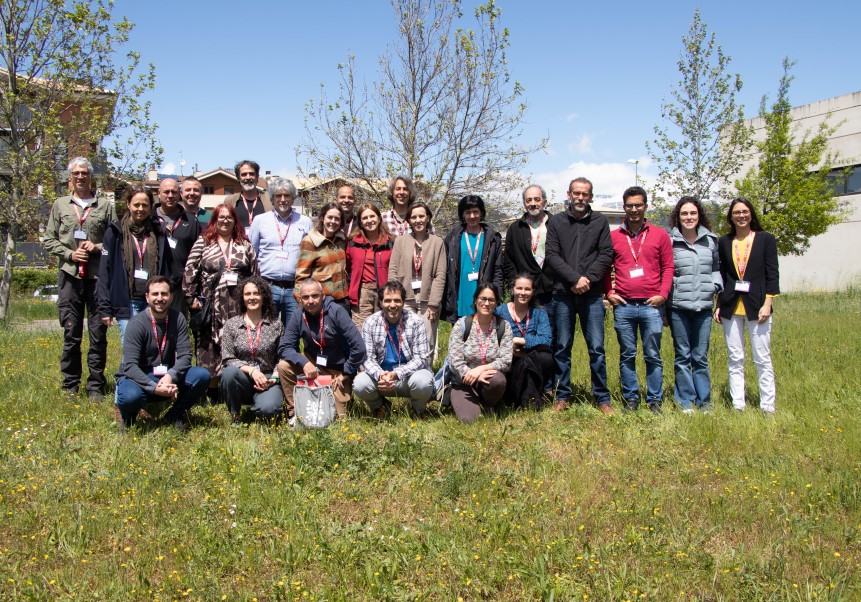
• Environmental experts from all over the country held a meeting yesterday in the framework of the ‘CICERÓN Itineraries’ to raise awareness of actions to manage and recover biodiversity.
• The event, held at the headquarters of the Pyrenean Institute of Ecology of the CSIC, served as a space for reflection between researchers, managers and society in order to address the challenges of ecosystem conservation from the scientific knowledge.
Researchers from the Spanish National Research Council (CSIC) - experts in terrestrial and aquatic ecology - presented yesterday in Jaca the work that the institution is doing to address the challenge of conservation and restoration of nature in a changing society. The meeting is part of the ‘CICERÓN Itineraries’ programme and brought together CSIC research staff with representatives of public administrations, companies, the media and social organisations. The event was also attended by the deputy vice-president for Innovation and Transfer of the CSIC, Ana Castro Morera; the institutional delegate of the CSIC in Aragon, Mª Jesús Lázaro; and Juan José Jiménez, director of the Pyrenean Institute of Ecology (IPE-CSIC), based in the Aragonese city.
In addition to promoting dialogue on nature conservation and restoration, the event was intended to be a letter of introduction to the potential of public science to offer rigorous knowledge, tools and proposals applicable to the environmental challenges currently facing many sectors of the territory. ‘CSIC science is ready to collaborate in decision-making, but to do so it needs spaces like this one, where it can be heard, contrasted and adapted to the realities of the field,’ said Castro. ‘This type of meeting has been fundamental for science to go further: when it is shared with those who decide, manage and communicate, it becomes a transforming action,’ he added.
A dynamic format designed to connect
The day combined a guided tour of the scientific facilities of the IPE-CSIC - including its herbarium and laboratories - with an audiovisual session and a participatory discussion. Seven videos featuring CSIC researchers were shown, showing specific cases of ecological restoration, from marine environments to agro-ecosystems or high mountain lakes.
The meeting was coordinated by Graciela Gil-Romera (IPE-CSIC) and Óscar Godoy (Doñana Biological Station, EBD-CSIC), who also moderated the debate. ‘We wanted to show that restoring nature is not only an ecological imperative, but also an opportunity for collaboration between science and society. This event has been an invitation to find out what public research can contribute to those who manage or transform the territory,’ said Gil-Romera. For his part, Óscar Godoy stressed that ‘restoration will only be effective if it is based on solid knowledge. But that knowledge needs to come out of the laboratory and be put into knowledge and dialogue with the people on the ground. That is what we have tried to do here.
Applied science from different ecosystems
The scientific presentations provided a broad and complementary vision of how to approach conservation and ecological restoration from different ecosystems and disciplines. For example, Jordi Pagès Fauria (Centro de Estudios Avanzados de Blanes, CEAB-CSIC) emphasised that in coastal systems ‘restoration implies understanding both ecological processes and social dynamics, as this is the only way to design a management that is resilient to global change’. Also in the marine field, microplastics expert Cristina Romera (Institute of Marine Sciences, ICM-CSIC) indicated that microplastics ‘are altering the carbon cycle in the ocean and science is exploring ways to reverse these effects, including through biological processes’.
EBD-CSIC researcher Laetitia Navarro shared with the audience that, in order to tackle any restoration project, ‘we have to be able to find the direction in which we want to restore, and for this it is necessary to recover a historical perspective’. In this sense, Miguel Clavero (EBD-CSIC) explained that his line of research is mobilising information on biodiversity and its distribution on scales of hundreds of years, which is embedded in historical archives.
Teresa Buchaca (CEAB-CSIC) remarked that high mountain lakes ‘are natural laboratories to observe the impact of human alterations’ and that restoring them ‘requires restoring their ecological functionality’. Bruno Moreira (Centro de Investigaciones sobre Desertificación, CIDE-Universidad de Valencia-Generalitat de Valencia - CSIC) reflected on the role of fire: ‘Knowing how fire works in Mediterranean ecosystems is essential. Prescribed burning can be a powerful tool if applied with ecological criteria’.
Likewise, Daniel Oro (CEAB-CSIC) recalled that animal populations ‘need space and time to recover. Restoration is also about restoring ecological connectivity and natural cycles. María R. Felipe-Lucia (IPE-CSIC) said that ecological restoration ‘must go hand in hand with environmental justice. The benefits of ecosystems must be distributed equitably among all actors in the territory’.
Institutional and territorial participation
The meeting was attended by a diverse representation of territorial actors, including officials from the Ordesa y Monte Perdido National Park (Government of Aragon), the Fauna and Flora Service of the Generalitat de Catalunya, the Aragon Nature Protection Council, as well as representatives of third sector organisations such as the Aragon Shepherds' School, Justicia Alimentaria and the Garúa cooperative. Companies such as Agresta S. Coop. and Paleoymás also took part, along with architectural studios such as Gyra Architects. On the media side, representatives of Aragón Radio, Ballena Blanca and the newspaper El País were present, which made it possible to open up scientific reflection to the general public.
CIDE Communication









